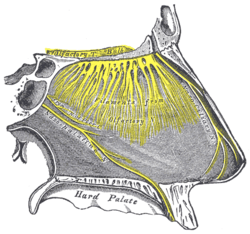Nasopalatine nerve
| Nasopalatine nerve | |
|---|---|
 Nerves of septum of nose. Right side (Nasopalatine is lower yellow line.) | |
 The sphenopalatine ganglion and its branches. (Termination of nasopalatine nerve labeled at bottom left.) | |
| Details | |
| From | maxillary nerve, pterygopalatine ganglion |
| Identifiers | |
| Latin | nervus nasopalatinus |
| TA | A14.2.01.043 |
| FMA | 52797 |
One branch of the pterygopalatine ganglion (Trigeminal nerve, Maxillary branch), longer and larger than the others, is named the nasopalatine nerve (sometimes called the long sphenopalatine nerve).
It enters the nasal cavity through the sphenopalatine foramen, passes across the roof of the nasal cavity below the orifice of the sphenoidal sinus to reach the septum, and then runs obliquely downward and forward between the periosteum and mucous membrane of the lower part of the septum.
It descends to the roof of the mouth through the incisive canal and communicates with the corresponding nerve of the opposite side and with the greater palatine nerve.
It supplies the palatal structures around the maxillary anterior teeth (central incisors, lateral incisors, and the canines).
It also furnishes a few filaments to the mucous membrane of the nasal septum.
The medial superior posterior nasal branches of maxillary nerve usually branches from the nasopalatine nerve.
It was first discovered by Domenico Cotugno.
Additional images
 Base of skull. Inferior surface.
Base of skull. Inferior surface.
See also
References
This article incorporates text in the public domain from the 20th edition of Gray's Anatomy (1918)
External links
- MedEd at Loyola GrossAnatomy/h_n/cn/cn1/cnb2.htm
- lesson9 at The Anatomy Lesson by Wesley Norman (Georgetown University) (nasalseptumner)
- Diagram 1 at adi-visuals.com
- Diagram 2 at adi-visuals.com